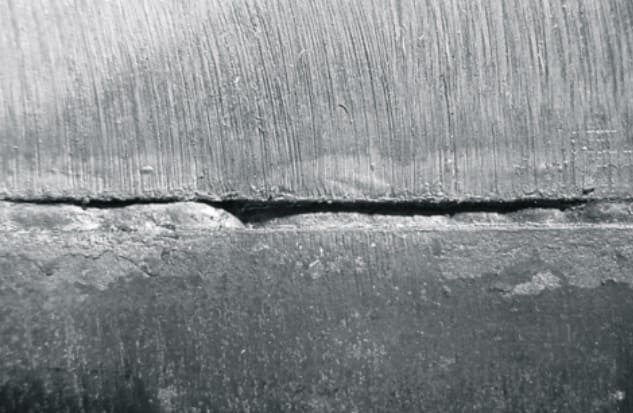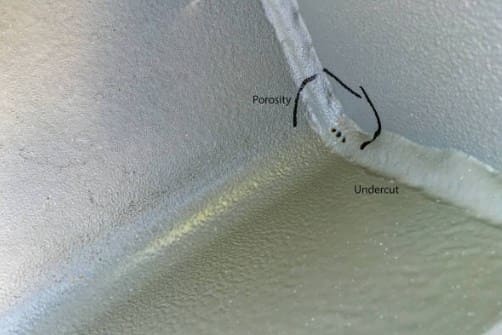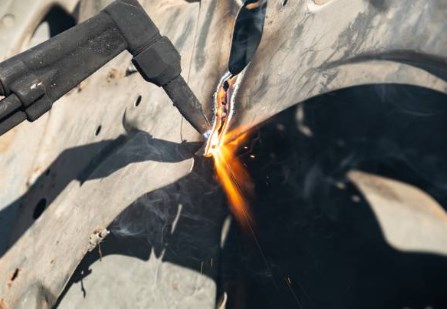Manual Metal Arc (MMA) welding, commonly known as stick welding, is one of the most versatile and widely used welding techniques in various industries. Its adaptability to different materials and environments makes it a favorite among welders. However, like any welding process, MMA welding is not without its challenges. In this comprehensive guide, we will explore the top 10 common flaws encountered in MMA welding and provide practical solutions to overcome them, brought to you by Megmeet Welding Technology.
Flaw 1: Porosity in Welds:
Porosity is the presence of tiny holes or gas pockets within the weld metal, which can weaken the weld and make it susceptible to cracking.

1) What causes pores?
Moisture: Damp electrodes or a wet workpiece can introduce hydrogen into the weld pool, leading to gas pockets.
Contaminants: Oil, grease, rust, or paint on the base metal can react during welding, causing porosity.
Long Arc Length: Excessively long arcs expose the weld pool to atmospheric gases.
2) Megmeet's Solutions:
Store Electrodes Properly: Keep electrodes in a dry, moisture-free environment. If electrodes are damp, bake them at a low temperature before use.
Clean the Base Metal: Thoroughly clean the workpiece using a wire brush or solvent to remove contaminants.
Optimize Arc Length: Maintain a short, stable arc to minimize exposure to atmospheric gases.
Flaw 2. Slag Inclusions
Slag inclusions occur when non-metallic solids (slag) get trapped in the weld metal. This defect can reduce the strength and integrity of the weld.
1) Why It Happens?
Inadequate Cleaning: Failure to remove slag between weld passes allows it to mix with the weld metal.
Incorrect Electrode Angle: Improper technique can trap slag within the weld.
Low Welding Current: Insufficient heat input prevents the slag from melting and flowing out.
2) Megmeet's Solutions:
Clean Between Passes: Use a chipping hammer and wire brush to remove slag before proceeding to the next pass.
Adjust Electrode Angle: Hold the electrode at a 20-30° angle relative to the workpiece.
Optimize Current Settings: Ensure the welding current matches the electrode type and thickness of the material.
Flaw 3. Cracking in Welds:
Cracks are a serious defect that can compromise the strength and durability of a welded joint. They can form during cooling or after the weld is complete.

1) What causes it?
Thermal Stress: Rapid cooling or shrinkage can cause cracks, especially in thick or high-carbon steel.
Hydrogen Absorption: High hydrogen levels in the weld area can lead to embrittlement.
Wrong Electrode Choice: Using an electrode not suited for the base material.
2) Megmeet's Tips:
Preheat the Workpiece: Especially for thick or high-carbon materials, preheating reduces cooling rates.
Use Low-Hydrogen Electrodes: Ensure electrodes are stored correctly to avoid moisture absorption.
Post-Weld Heat Treatment: Apply heat treatment to relieve residual stresses.
Flaw 4. Lack of Fusion:
Lack of fusion means the weld metal fails to properly bond with the base metal, leading to weak joints that can break under stress.

1) What causes it?
Low Heat Input: Insufficient amperage or voltage fails to melt the base metal adequately.
Fast Travel Speed: Moving too quickly prevents proper fusion.
Poor Joint Preparation: Gaps or contamination in the joint reduce fusion.
2) Megmeet's Solutions:
Increase Welding Current: Adjust the amperage to improve penetration.
Slow Down: Decrease travel speed to allow sufficient time for fusion.
Ensure Joint Preparation: Clean and prepare the joint properly before welding.
Flaw 5. Undercutting:
Undercutting is a groove that forms at the toe of the weld bead, reducing the thickness of the base metal and weakening the joint.

1) What causes it?
High Welding Current: Excessive heat input melts too much base metal.
Fast Travel Speed: Moving too quickly doesn’t allow the weld pool to fill the joint.
Incorrect Electrode Angle: An improper angle can cause uneven heating.
2) Megmeet's Solutions:
Lower the Amperage: Reduce current to prevent excessive melting.
Slow Travel Speed: Allow the weld metal to fill the joint properly.
Optimize Electrode Angle: Keep the electrode at a 15-20° angle from the vertical.
Flaw 6. Excessive Spatter:
Spatter refers to small droplets of molten metal that get ejected from the weld pool, creating a mess on your workpiece.
1) What causes it?
High Current or Voltage: Excessively high settings eject molten metal droplets.
Long Arc Length: Holding the electrode too far from the workpiece increases spatter.
Poor-Quality Electrodes: Damp or low-quality electrodes contribute to spatter.
2) Megmeet's Solutions:
Adjust Current and Voltage: Refer to electrode specifications for ideal settings.
Maintain Short Arc: Keep the arc length short to reduce spatter.
Use High-Quality Electrodes: Ensure electrodes are dry and stored properly.
Flaw 7. Arc Blow:
Arc blow occurs when the arc becomes unstable, often resulting in uneven weld beads or poor penetration. It’s particularly common in DC welding, especially near magnetic materials.
1) What causes it?
Magnetic Fields: Especially in DC welding, magnetic materials can disrupt the arc.
Ground Clamp Position: Incorrect positioning of the ground clamp can cause instability.
Welding Near Existing Welds: The magnetic field from previous welds can interfere.
2) How to Combat Arc Blow:
Reposition Ground Clamp: Move the ground clamp to a different location.
Use AC Welding: AC current is less susceptible to magnetic interference.
Change Welding Direction: Welding in the opposite direction can counteract magnetic forces.
Flaw 8. Burn-Through (Excessive Penetration):
Burn-through happens when the weld metal penetrates too deeply, causing holes in the workpiece, especially on thinner materials.

1) What causes it?
High Amperage: Too much heat input melts through thinner materials.
Slow Travel Speed: Moving too slowly overheats the workpiece.
Larger Electrode: Using an electrode too big for the material thickness.
2) Prevention Tips:
Reduce Amperage: Lower the current to avoid excessive heat.
Increase Travel Speed: Move faster to prevent overheating.
Choose the Right Electrode: Select a smaller electrode for thinner materials.
Flaw 9. Difficulty Striking an Arc:
If you find it hard to strike or maintain an arc, it can disrupt your welding process and lead to poor weld quality.
1) What causes it?
Damp Electrodes: Moisture on the electrode prevents a stable arc.
Incorrect Amperage: Settings are too low or high for the electrode type.
Lack of Skill: Inexperience can make it hard to strike and maintain an arc.
2) Megmeet's Solutions:
Use Fresh Electrodes: Ensure electrodes are dry and stored properly.
Adjust Amperage Settings: Match the current to the electrode size and type.
Practice Arc-Striking: Train on scrap metal to improve technique.
Flaw 10. Weld Bead Inconsistency:
Inconsistent weld beads can be aesthetically unappealing and may indicate issues with weld quality.
1) What causes it?
Inconsistent Arc Length: Fluctuating the arc can lead to uneven beads.
Unsteady Hand: Lack of control over the electrode.
Incorrect Settings: Improper current or voltage settings.
2) Megmeet's Solutions:
Maintain Consistent Arc: Keep the arc length steady throughout the weld.
Steady Your Hand: Practice to improve control and consistency.
Check Machine Settings: Adjust settings as needed for uniform weld beads.
Conclusion:
MMA welding is a skill that takes time and practice to master. But by understanding these 10 common MMA welding problems and their solutions, you’re already one step closer to becoming a pro. Whether it's porosity, cracking, or arc blow, addressing these issues head-on will save you time, materials, and frustration in the long run.
Remember, the key to great welding is preparation. Clean your materials, set up your machine correctly, and practice proper technique. Soon, you’ll be laying down beautiful, strong welds that you can be proud of. If you want to learn welding tips or welding solutions, you can collect the Megmeet News Center Page or follow our LinkedIn page.
Related articles:
1. Manual Metal Arc Welding: Why Every Weld Matters Much?
2. MMA Welding or SMAW Welding: What You Need to Know?
3. CO2 Gas Shielded Welding VS. Manual Welding VS. TIG Welding
4. MMA "Stick" Welding: What is Open Circuit Voltage (OCV)?
5. MIG/MAG, MMA, TIG Welding: Choosing the Right Technique








